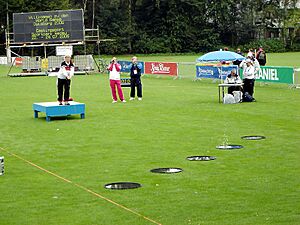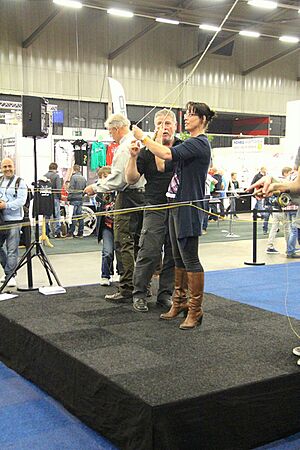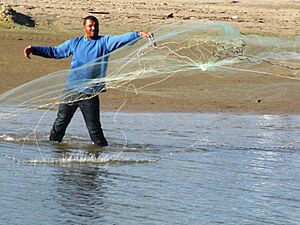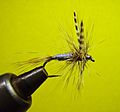Casting (fishing) facts for kids
In fishing, casting means throwing your bait or lure into the water. You use a fishing rod, reel, and line to do this. Different rods and reels are made just for casting. The main goal of casting is to get your bait or lure to where the fish are swimming.
Contents
Casting: Getting Your Lure to the Fish
How to Cast: The Basics
The most accurate way to cast is called the 'overhead cast'. To do this, you raise your rod and reel behind your head. Then, you quickly flick the rod forward, letting go of the line as you finish the cast.
Another way is the 'side cast'. This is less powerful but easier to learn. You swing the rod back in a horizontal motion, then quickly move it forward, releasing the line. Both of these basic methods have different ways to do them. They are popular for spinning and casting rods. Fly fishing uses similar movements, but you release the line differently. For the best results, your rod, reel, line, and lure should all match in weight.
Spinning Rods and Reels
It's easy to learn how to cast with a spinning rod and reel. You can usually get the hang of it in just a few minutes! There are two main types of spinning reels: open-faced and closed-faced. They work a bit differently.
With a closed-faced reel, you hold down a push-button and then release it when you finish your cast. For open-faced reels, you first open a part called the bail. Then, you hold the line with your pointer finger and release it as you cast. Open-faced reels can sometimes cause the line to twist when you make short casts. This can lead to annoying tangles on the spool. Spinning rods and reels work best with light line and small lures. They are also great for casting when the wind is blowing.
Baitcasting Rods and Reels
Baitcasting reels come in many sizes and can hold different amounts of line. They also have various features depending on what you use them for. A common feature is a horizontal spool where the line wraps around. Baitcasting reels usually give you more control over your line and lure. This means you can cast with better accuracy than with other types of reels. They are also better at handling heavier lines and lures.
It takes some skill and Practice to get good at using a baitcasting rod and reel. To cast, you press and hold a push-button until you want to release the line. Baitcasting reels can sometimes 'snarl' or 'backlash'. This happens because the line comes off the reel very fast during the cast. When your lure hits the water, the line stops, but the reel's spool keeps spinning. This causes the line to get tangled up. It happens even more when you cast into the wind. Practicing with baitcasting reels helps a lot with this problem.
To help control snarling, baitcasting reels usually have a brake. This brake automatically stops the spool when the line stops. Reels can have either a magnetic brake or a centrifugal brake. Some even have both! You need to adjust these brakes carefully. The goal is to find a balance between casting a good distance and preventing backlashes. Many anglers set the brake lightly to cast further. Then, they control the braking by gently pressing their thumb on the spool. Low-profile baitcasting reels are made especially for using your thumb this way.
Flipping and Pitching
Two special types of casts with a baitcasting rod became popular with tournament fishermen:
- Flipping: This is a very short cast, only a few feet. It's used to drop a lure into thick plants or other hiding spots for fish. It needs a stiff rod and strong braided fishing line.
- Pitching: This is a short cast, just a few yards. Like flipping, it's for heavy cover and also works with a stiff rod and strong braided fishing line.
In both methods, you use the rod to swing the lure, like a pendulum, out over the water. The lure enters the water very quietly. This helps make sure you don't scare the fish away.
Fly Rods and Reels
Fly fishermen use special lures called artificial flies. Most flies are very light. They are so light that you couldn't cast them with other types of rods and reels. Fly rods work differently because they use a much heavier line than other fishing setups. It's actually the heavy line that you are casting, and the light fly just goes along with it!
Fly casting might look hard, but it's not as difficult as it seems. Most beginners can learn the basic cast in just a couple of hours. Fly casting is more involved than other types of casting. There are even fly fishing schools that teach you how to do it!
To cast a fly rod, you pull several feet of line off the reel. You move the rod tip back, then in one smooth motion, you move it forward, speeding up as you release the line. When fishing in streams and rivers, trees and shrubs on the bank might stop you from doing an overhead cast. In these cases, you can use a 'roll cast'. With this cast, the fisherman forces the rod tip down to roll the line forward.
Most fly lines are rated by a weight system. A 1wt (one weight) line is very light. A 13wt line is very heavy and would be used for large salt water fish. Rods and reels are also rated by the weight of the line they are made for. Unfortunately, there isn't one perfect size for all kinds of fish and fishing situations.
Net Casting
The word "casting" can also mean throwing a net. You throw the net by hand so it spreads out on the water and sinks. Fish get caught in the net, and then you pull it back in. Net casting is often used to catch smaller fish to use as bait. Modern cast nets usually have a radius of 4 to 12 feet (1.2 to 3.6 meters). A large net full of fish might need more than one person to pull it in. Cast nets sometimes use a 'net thrower' device. This helps spin the net as it's thrown, keeping it open. Cast nets work best in shallow water.
Competitive Casting

Casting is also a sport, known as Casting Sport! The sport is overseen by the International Casting Sport Federation (ICSF). As of April 2014, there were 31 countries involved.
Casting competitions were popular in England and the United States in the late 1800s. The first tournament was held near London in 1881. In 1955, 14 different national associations started the ICF (which is now the ICSF). The ICSF sets all the international standards for the sport. It also sponsors tournaments and recognizes world records for accuracy and distance.
In this sport, people use plastic weights or flies without hooks. Competitions can happen on water or on athletic fields. There are different competitive groups for almost all types of fly, fixed spool, and revolving spool tackle. There are also different classes for competitors. Competitive casting is even part of the World Games.
In 2014, the World Championship was held in Szamotuly, Poland, from September 3rd to 7th.
Images for kids









